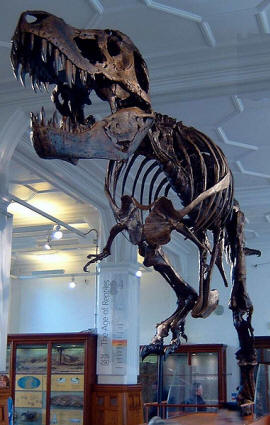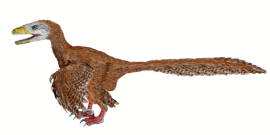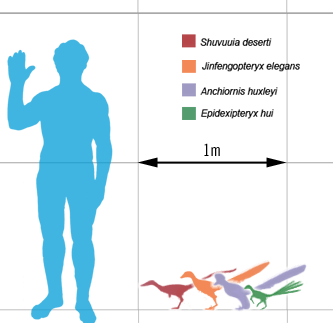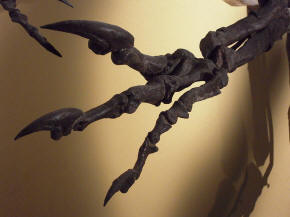Shortened forelimbs in relation to
hind legs was a common trait among theropods, most notably in the
abelisaurids (such as
Carnotaurus) and the
tyrannosaurids (such as
Tyrannosaurus). This
trait was, however, not universal:
spinosaurids had well
developed forelimbs, so also did many
coelurosaurs. One
genus,
Xuanhanosaurus, has
also been claimed to have been quadrupedal because of its comparatively
robust forelimbs, but this is no longer thought to be likely.
The hands are also very different
among the different groups. the most common is an appendage consisting of 3
fingers, the digits I, II and III (or possibly II, III and IV) with sharp
claws. Some basal theropods (Herrerasaurus,
Eoraptor) had 4
digits, and also a reduced
metacarpal V.
Ceratosaurians usually
and 4 digits, while most tetanurans had 3.
The forelimbs' scope of use is also
believed to have also been different among different families. The
spinosaurids could have
used their powerful forelimbs to hold fishes. Some small
coelurosaurus (dromaeosaurids,
scansoriopterygids) are
believed to have used their forelimbs to climb in trees, and birds, which are
believed to be descendants of theropods, use them for flight.
Forelimb Movement
Contrary to the way theropods have
often been reconstructed in art and the popular media, the range of motion
of theropod forelimbs was severely limited, especially compared with the
forelimb dexterity of humans and other primates. Most notably,
theropods and other bipedal saurischian dinosaurs (including the bipedal
prosauropods) could not
pronate their
hands—that is, they could not rotate the forearm so that the palms faced the
ground or backwards towards the legs. In humans, pronation is achieved by
motion of the
radius relative to the
ulna (the two bones of
the forearm). In saurischian dinosaurs, however, the end of the radius near
the elbow was actually locked into a groove of the ulna, preventing any
movement. Movement at the wrist was also limited in many species, forcing
the entire forearm and hand to move as a single unit with little
flexibility. In theropods and prosauropods, the only way for the palm to
face the ground would have been by lateral splaying of the entire forelimb,
as in a bird raising its wing.
In carnosaurs like
Acrocanthosaurus, the
hand itself retained a relatively high degree of flexibility, with mobile
fingers. This was also true of more basal theropods such as herrerasaurs and
dilophosaurs.
Coelurosaurs showed a
shift in the use of the forearm, with greater flexibility at the shoulder
allowing the arm to be raised towards the horizontal plane, and to even
greater degrees in flying
birds. However, in
coelurosaurs such as
ornithomimosaurs and
especially
dromaeosaurs, the hand
itself had lost most flexibility, with highly inflexible fingers.
Dromaeosaurs and other
maniraptorans also
showed increased mobility at the wrist not seen in other theropods, thanks
to the presence of a specialized half-moon shaped wrist bone (the
semi-lunate carpal) that allowed the whole hand to fold backward towards the
forearm in the manner of modern birds.
-----------------Optional Reading Below This
Point-------------------
Evolutionary History
During the late
Triassic, a number of
primitive proto-theropod and theropod dinosaurs existed and evolved
alongside each other.
The earliest and most primitive of
the carnivorous dinosaurs were
Eoraptor of Argentina and the
herrerasaurs. The
herrerasaurs existed during the early late Triassic (Late
Carnian to Early
Norian). They were
found in North America and
South America and
possibly also India and Southern
Africa. The
herrerasaurs were characterised by a
mosaic of primitive and
advanced features. Some paleontologists have in the past considered the
herrerasaurians to be members of Theropoda, while other theorized the group
to be
basal saurischians, and
may even have evolved prior to the saurischian-ornithischian split.
Cladistic analysis
following the discovery of
Tawa, another Triassic
dinosaur, suggests the herrerasaurs likely were early theropods.
The earliest and most primitive
unambiguous theropods (or alternatively, "Eutheropoda" - 'True Theropods')
are the
Coelophysoidea. The
Coelophysoidea were a group of widely distributed, lightly built and
potentially gregarious animals. They included small hunters like
Coelophysis and (possibly)
larger predators like
Dilophosaurus. These
successful animals continued from the Late Carnian (early Late Triassic)
through to the
Toarcian (late
Early Jurassic).
Although in the early cladistic
classifications they were included under the
Ceratosauria and
considered a side-branch of more advanced theropods, they may have been
ancestral to all other theropods (which would make them a paraphyletic group).
The somewhat more advanced
ceratosaurs (including
Ceratosaurus and
Carnotaurus) appeared
during the Early Jurassic and continued through to the Late Jurassic in
Laurasia. They competed
alongside their more anatomically advanced tetanuran relatives and—in the
form of the
abelisaur
lineage—lasted to the end of the Cretaceous in
Gondwana.
The
Tetanurae are more
specialised again than the ceratosaurs. They are subdivided into the basal
Megalosauroidea
(alternately
Spinosauroidea) and the
more derived
Avetheropoda.
Megalosauridae were
primarily Middle Jurassic to Early Cretaceous predators, and their
spinosaurid relatives'
remains are mostly from Early and Middle Cretaceous rocks. Avetheropoda, as
their name indicates, were more closely related to birds and are again
divided into the
Allosauroidea (the
diverse
carcharodontosaurs) and
the
Coelurosauria (a very
large and diverse dinosaur group including the birds).
Thus, during the late Jurassic,
there were no fewer than four distinct lineages of theropods—ceratosaurs,
megalosaurs, allosaurs, and coelurosaurs—preying on the abundance of small
and large herbivorous dinosaurs. All four groups survived into the
Cretaceous, and three of those—the ceratosaurs, coelurosaurs, and
allosaurs—survived to end of the period, where they were geographically
separate, the ceratosaurs and allosaurs in Gondwana, and the coelurosaurs in
Laurasia.
Of all the theropod groups, the
coelurosaurs were by far the most diverse. Some coelurosaur groups that
flourished during the Cretaceous were the
tyrannosaurids
(including
Tyrannosaurus) the
dromaeosaurids
(including
Velociraptor and
Deinonychus, which are
remarkably similar in form to the oldest known bird,
Archaeopteryx), the
bird-like
troodontids and
oviraptorosaurs, the
ornithomimosaurs (or
"ostrich dinosaurs"), the strange giant-clawed herbivorous
therizinosaurs, and the
avialans, which include
modern
birds and is the only
dinosaur lineage to survive the
Cretaceous-Paleogene extinction event.
While the roots of these various groups are found in the Middle Jurassic,
they only became abundant during the Early Cretaceous. A few
paleontologists, such as
Gregory S. Paul, have
suggested that some or all of these advanced theropods were actually
descended from flying dinosaurs or proto-birds like
Archaeopteryx that lost
the ability to fly and returned to a terrestrial habitat.
Classification
History of Classification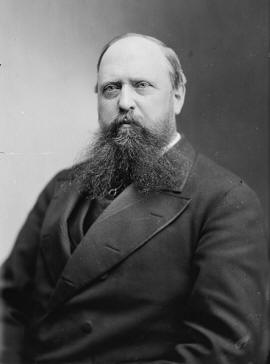
The name Theropoda (meaning "beast
feet") was first coined by
O.C. Marsh (picture at right) in 1881.
Marsh initially named Theropoda as a
suborder to include the
family
Allosauridae, but later
expanded its scope, re-ranking it as an
order to include a wide
array of "carnivorous" dinosaur families, including
Megalosauridae,
Compsognathidae,
Ornithomimidae,
Plateosauridae and
Anchisauridae (now
known to be herbivorous
prosauropods) and
Hallopodidae (now known
to be relatives of crocodilians). Due to the scope of Marsh's Order
Theropoda, it came to replace a previous taxonomic group that Marsh's rival
E.D. Cope had created
in 1866 for the carnivorous dinosaurs,
Goniopoda ("angled feet").
By the early 20th century, some
paleontologists, such as
Friedrich von Huene, no
longer considered carnivorous dinosaurs to have formed a natural group.
Huene abandoned the name Theropoda, instead using
Harry Seeley's Order
Saurischia, which Huene
divided into the suborders
Coelurosauria and
Pachypodosauria. Huene
placed most of the small theropod groups into Coelurosauria, and the large
theropods and prosauropods into Pachypodosauria, which he considered
ancestral to the
Sauropoda (prosauropods
were still thought of as carnivorous at this time, owing to the incorrect
association of
rauisuchian skulls and
teeth with prosauropod bodies, in animals such as
Teratosaurus). In W.D.
Matthew and
Barnum Brown's 1922
description of the first known
dromaeosaurid (Dromaeosaurus
albertensis), they became the first
paleontologists to exclude prosauropods from the carnivorous dinosaurs, and
attempted to revive the name Goniopoda for that group, though neither of
these suggestions were accepted by other scientists.
It was not until 1956 that Theropoda
came back into use as a
taxon containing the
carnivorous dinosaurs and their descendants, when
Alfred Romer
re-classified the Order Saurischia into two suborders, Theropoda and
Sauropoda. This basic
division has survived into modern paleontology, with the exception of,
again, the Prosauropoda, which Romer included as an
infraorder of
theropods. Romer also maintained a division between Coelurosauria and
Carnosauria (which he
also ranked as infraorders). This dichotomy was upset by the discovery of
Deinonychus and
Deinocheirus in 1969,
neither of which could be classified easily as "carnosaurs" or
"coelurosaurs." In light of these and other discoveries, by the late 1970s
Rinchen Barsbold
created a new series of theropod infraorders: Coelurosauria,
Deinonychosauria,
Oviraptorosauria,
Carnosauria,
Ornithomimosauria, and
Deinocheirosauria.
With the advent of
cladistics and
phylogenetic nomenclature
in the 1980s, and their development in the 1990s and 2000s, a clearer
picture of theropod relationships began to emerge. Several major theropod
groups were named by
Jacques Gauthier in
1986, including the
clade
Tetanurae for one
branch of a basic theropod split with another group, the
Ceratosauria. As more
information about the link between dinosaurs and
birds came to light,
the more bird-like theropods were grouped in the clade
Maniraptora (also named
by Gauthier in 1986). These new developments also came with a recognition
among most scientists that birds arose directly from maniraptoran theropods
and, with the abandonment of ranks in cladistic classification, the
re-evaluation of birds as a subset of theropod dinosaurs that happened to
have survived the Mesozoic extinctions into the present.
Major Groups
Theropods are a highly diverse group, and many major
Mesozoic lineages have been identified:
